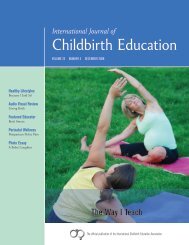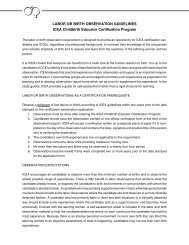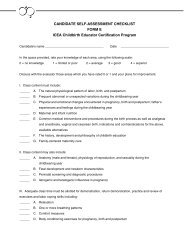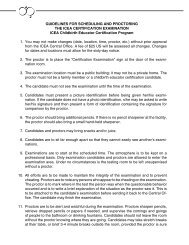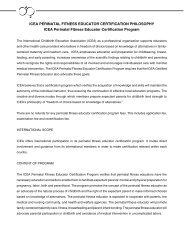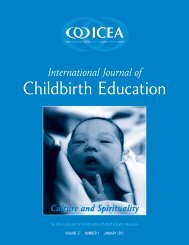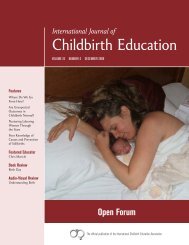JOURNAL - International Childbirth Education Association
JOURNAL - International Childbirth Education Association
JOURNAL - International Childbirth Education Association
Create successful ePaper yourself
Turn your PDF publications into a flip-book with our unique Google optimized e-Paper software.
RECIPROCAL INTERACTIONS AS FOUNDATION FOR ATTACHMENT from page 5<br />
ment when lying down. After birth, women find great<br />
pleasure in watching movements of their newborns and<br />
relating them to sensations of pregnancy. Such observations<br />
probably have an effect on integrating attachment<br />
feelings for the fetus, the baby imagined in pregnancy,<br />
and the real baby (Brazelton and Cramer 1990).<br />
Much of the unborn and newborn baby’s movement<br />
is reflexive in nature. These reflexes allow babies to respond<br />
to and act on the world around them (Cole and<br />
Cole 1993). For example, the crawling reflex may play a<br />
role in the baby’s descent during labor. Bringing the hand<br />
to the mouth and sucking can be observed frequently<br />
throughout the prenatal period. After birth, this skill is an<br />
important component of infant self-comforting. Movement<br />
is, of course, a measure of fetal well-being. Introducing<br />
the idea of fetal movement counts, as a way of spending<br />
time with the baby to affirm wellness, supports a central<br />
component of healthy parenting: paying attention. This is<br />
more holistic than recommending fetal movement counts<br />
solely as a way to identify a potential problem. It is hard<br />
to engage in social discourse when all you are listening<br />
for is bad news.<br />
Just as before birth, the foundations of attachment<br />
work between parent and baby after birth are largely<br />
sensory. To the interaction, the baby brings all of the<br />
sensory and motor skills developed during the prenatal<br />
period. The quiet alert state into which babies are born<br />
allows them to demonstrate not only that they can see,<br />
hear, feel, and smell their parents, but that it is their parents’<br />
voices, touch, faces, and odors that are preferred. A<br />
newborn recognizes the sound of the mother’s or father’s<br />
voice, turns towards it, scans the environment visually<br />
to find that familiar person, and often orients the body<br />
toward the parent. When in a parent’s arms, the baby<br />
nestles in, clings with the grasp reflex, and roots to find<br />
the comfort of suckling. New parents bring the same<br />
sensory awareness to their babies. The very appearance<br />
of the newborn draws out nurturing responses: head large<br />
6 • IJCE Vol. 13 No. 4<br />
B<br />
in proportion to the rest of the body, rounded forehead,<br />
large eyes, and round, full cheeks all make giving over<br />
to the needs of the baby easier (Lorenz 1943). In the<br />
first days after birth, mothers recognize their newborns<br />
readily by odor (Porter, Cernoch, and McLaughlin 1983).<br />
This primal sensitivity heightens awareness of the baby<br />
in ways that baby books and parenting classes cannot.<br />
Baby observation becomes a full-time job. The intensity of<br />
this observation is reflected in the questions asked about<br />
physical appearance, newborn behaviors, and caretaking<br />
skills. As professionals, it is easy to overlook the meaning<br />
of these questions. For the parents, the ability to distinguish<br />
between normal and abnormal, what to expect, and<br />
how to respond are literally issues of life and death. The<br />
shadow side of the attachment work going on is fear of<br />
loss. Taming the monsters of those fears is a large part<br />
of the work of postpartum, learning to believe in one’s<br />
ability to parent in such a way that both parent and baby<br />
will survive and thrive.<br />
Professionals can assist parents in beginning awareness<br />
of the reciprocal nature of interactions with their<br />
babies by talking with them, both before and after birth,<br />
about their babies’ emerging sensory-motor skills. Even<br />
well-educated parents who have seen the unborn baby<br />
several times on sonogram, know the sex of the baby, or<br />
have named the baby are often surprised to learn that<br />
babies are born innately social — and that social interaction<br />
begins before birth. Many parents have not brought<br />
to conscious awareness the reality that their baby has<br />
sensory competencies before as well as after birth.<br />
Questions such as the following, asked during pregnancy,<br />
invite parents to notice the reciprocal nature of<br />
interactions occurring with their babies:<br />
• When is the baby most active?<br />
• D o c e r t a i n p o s i t i o n s y o u<br />
are in change the baby’s activity?<br />
• Does your baby move differently when it has been<br />
a while since you have eaten<br />
or right after a meal?<br />
• Are you becoming more<br />
aware of the baby’s sleep<br />
and awake pattern? What is<br />
that pattern like?<br />
• Does the baby seem to respond<br />
differently to different<br />
voices. For example, what<br />
happens when the baby is<br />
moving and you call your<br />
partner (or a sibling) closer<br />
to watch?<br />
• Are there any sounds your<br />
baby seems to like, such as a<br />
certain type of music? Have<br />
you noticed the baby startle<br />
or become almost overactive<br />
in response to any sounds?<br />
When the baby is active and<br />
you (your continued partner, on a sibling)<br />
page 7



